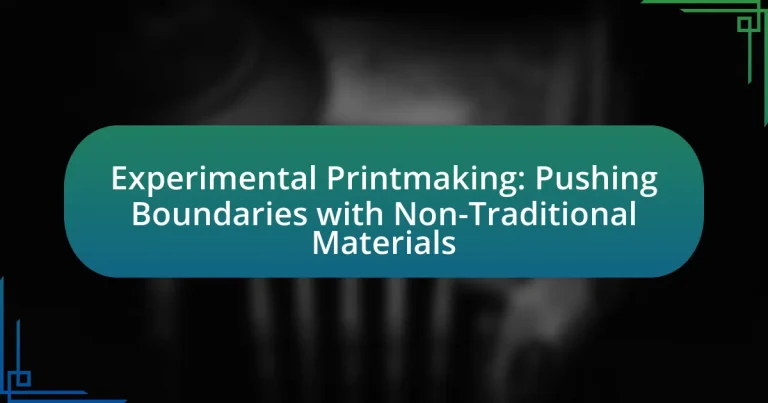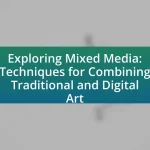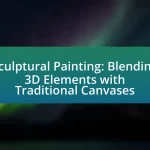Experimental printmaking is a contemporary art technique that utilizes non-traditional materials and innovative methods to create unique prints. This approach diverges from conventional printmaking by incorporating diverse substrates, inks, and processes, allowing artists to explore new textures and visual effects. Key characteristics include the emphasis on creativity, spontaneity, and the integration of mixed media, which challenges established norms. The article examines the historical influences on experimental printmaking, notable artists in the field, and the benefits and challenges of using non-traditional materials. Additionally, it provides guidance for beginners on techniques, materials, and safety considerations essential for successful experimentation in printmaking.
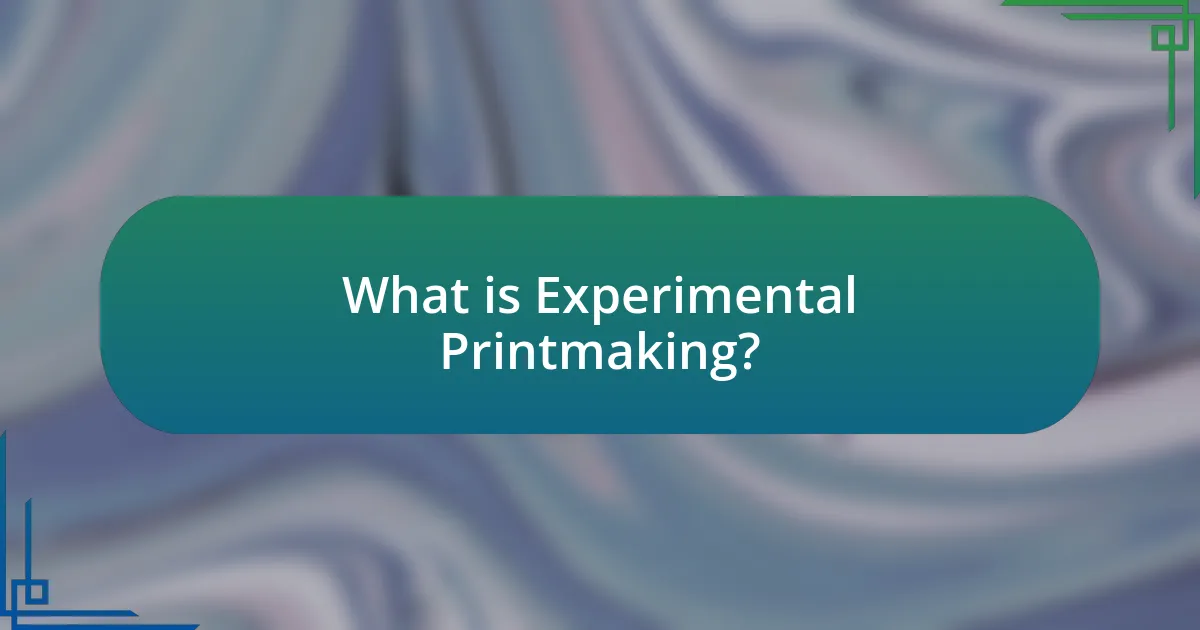
What is Experimental Printmaking?
Experimental printmaking is a technique that explores innovative methods and materials beyond traditional printmaking practices. This approach allows artists to manipulate various substrates, inks, and processes, resulting in unique and often unpredictable outcomes. For instance, artists may incorporate non-traditional materials such as fabric, wood, or found objects, which can lead to diverse textures and visual effects not achievable through conventional means. The flexibility of experimental printmaking encourages creativity and challenges the established norms of the medium, making it a vital aspect of contemporary art.
How does Experimental Printmaking differ from traditional printmaking?
Experimental printmaking differs from traditional printmaking primarily in its use of non-conventional materials and techniques. While traditional printmaking typically adheres to established methods such as woodcut, etching, or lithography, experimental printmaking encourages innovation by incorporating diverse materials like fabric, found objects, and digital elements. This approach allows artists to explore new textures, forms, and processes, resulting in unique and often unpredictable outcomes. For instance, artists may use unconventional inks or substrates, which can lead to a broader range of visual effects compared to the more standardized results of traditional methods.
What are the key characteristics of Experimental Printmaking?
Experimental printmaking is characterized by its innovative use of non-traditional materials and techniques that challenge conventional printmaking methods. This approach often incorporates mixed media, allowing artists to blend various textures and forms, resulting in unique prints that may include elements like fabric, found objects, or digital components. Additionally, experimental printmaking emphasizes the process of creation, encouraging spontaneity and exploration, which can lead to unexpected outcomes and artistic expressions. The integration of these diverse materials and methods reflects a broader trend in contemporary art, where boundaries between disciplines are increasingly blurred, fostering a dynamic environment for artistic experimentation.
Why is innovation important in Experimental Printmaking?
Innovation is important in Experimental Printmaking because it allows artists to explore new techniques and materials, thereby expanding the boundaries of traditional printmaking. By integrating non-traditional materials and methods, artists can create unique textures, forms, and visual narratives that challenge conventional aesthetics. For instance, the use of digital technology in printmaking has led to the development of hybrid techniques that combine traditional print processes with modern digital tools, resulting in innovative artworks that resonate with contemporary themes. This evolution not only enhances artistic expression but also engages audiences in novel ways, making innovation a crucial element in the ongoing dialogue within the art community.
What role do non-traditional materials play in Experimental Printmaking?
Non-traditional materials play a crucial role in experimental printmaking by expanding the range of textures, colors, and techniques available to artists. These materials, which can include anything from fabric and wood to found objects and digital elements, allow for innovative approaches that challenge conventional printmaking methods. For instance, artists can create unique impressions and layered effects that traditional inks and papers cannot achieve, thereby enhancing the expressive potential of their work. This integration of diverse materials fosters creativity and encourages artists to explore new aesthetic possibilities, ultimately redefining the boundaries of printmaking as an art form.
How do non-traditional materials expand creative possibilities?
Non-traditional materials expand creative possibilities by allowing artists to explore innovative techniques and unique textures that traditional materials cannot provide. For instance, using materials like fabric, metal, or recycled objects in printmaking enables the creation of multidimensional works that challenge conventional aesthetics. This approach has been validated by artists who have successfully integrated unconventional items, such as found objects or organic materials, into their processes, resulting in distinctive visual narratives and expanded artistic expression. The incorporation of these materials fosters experimentation, leading to new forms and methods that redefine the boundaries of printmaking.
What types of non-traditional materials are commonly used?
Commonly used non-traditional materials in experimental printmaking include fabric, wood, metal, and found objects. These materials allow artists to explore unique textures and forms, enhancing the creative process. For instance, fabric can absorb ink differently than paper, resulting in varied visual effects, while wood and metal can provide distinct surface qualities that influence the final print. Found objects, such as leaves or everyday items, introduce organic shapes and patterns, further expanding the possibilities in printmaking.
What are the historical influences on Experimental Printmaking?
Historical influences on Experimental Printmaking include the evolution of printmaking techniques, the impact of modern art movements, and the integration of technology. The development of lithography in the late 18th century allowed artists to explore new textures and forms, while movements such as Dadaism and Surrealism in the early 20th century encouraged the use of unconventional materials and methods. Additionally, advancements in digital technology in the late 20th century expanded the possibilities for printmakers, enabling the incorporation of mixed media and interactive elements. These influences collectively shaped the diverse practices seen in contemporary experimental printmaking.
How have past movements shaped current practices?
Past movements in printmaking, such as Dadaism and Surrealism, have significantly influenced current practices by encouraging artists to explore unconventional materials and techniques. Dadaism, which emerged in the early 20th century, rejected traditional aesthetics and embraced randomness, leading to the incorporation of found objects and mixed media in printmaking. This legacy is evident today as contemporary artists utilize non-traditional materials like fabric, plastic, and digital elements to create innovative prints. Furthermore, the Surrealist emphasis on dream imagery and subconscious exploration has inspired modern printmakers to experiment with layering and abstraction, pushing the boundaries of what printmaking can achieve. These historical movements laid the groundwork for a more inclusive and experimental approach in contemporary printmaking, fostering a culture of innovation and exploration.
What artists have significantly contributed to this field?
Artists such as Robert Rauschenberg, Kiki Smith, and El Anatsui have significantly contributed to the field of experimental printmaking using non-traditional materials. Robert Rauschenberg is known for his innovative use of found objects and mixed media in his prints, which challenged conventional printmaking techniques. Kiki Smith has explored themes of the human body and nature through her unique approaches to printmaking, often incorporating unconventional materials like fabric and wax. El Anatsui has transformed the printmaking landscape by integrating materials such as bottle caps and aluminum into his works, creating intricate textures and forms that push the boundaries of traditional printmaking. These artists exemplify the evolution of printmaking by expanding its materials and methods, thereby influencing contemporary practices in the field.
How can artists effectively incorporate non-traditional materials?
Artists can effectively incorporate non-traditional materials by experimenting with diverse textures, colors, and forms that challenge conventional printmaking techniques. This approach allows artists to create unique visual experiences and expand the boundaries of their work. For instance, using materials such as fabric, found objects, or recycled items can introduce unexpected elements into the printmaking process, enhancing creativity and innovation. Historical examples include artists like Robert Rauschenberg, who famously used non-traditional materials in his combines, demonstrating that integrating unconventional items can lead to groundbreaking artistic expressions.
What challenges do artists face when using non-traditional materials?
Artists face several challenges when using non-traditional materials, including issues related to material compatibility, durability, and unpredictability in the final outcome. Non-traditional materials often do not behave like conventional art supplies, leading to difficulties in achieving desired effects or maintaining structural integrity over time. For instance, organic materials may decompose or react adversely with other substances, while unconventional inks or substrates may not adhere properly, resulting in compromised artwork. Additionally, the lack of established techniques for these materials can hinder artists’ ability to effectively manipulate them, requiring extensive experimentation and adaptation. This unpredictability can lead to frustration and increased production time, as artists must navigate trial and error to achieve satisfactory results.
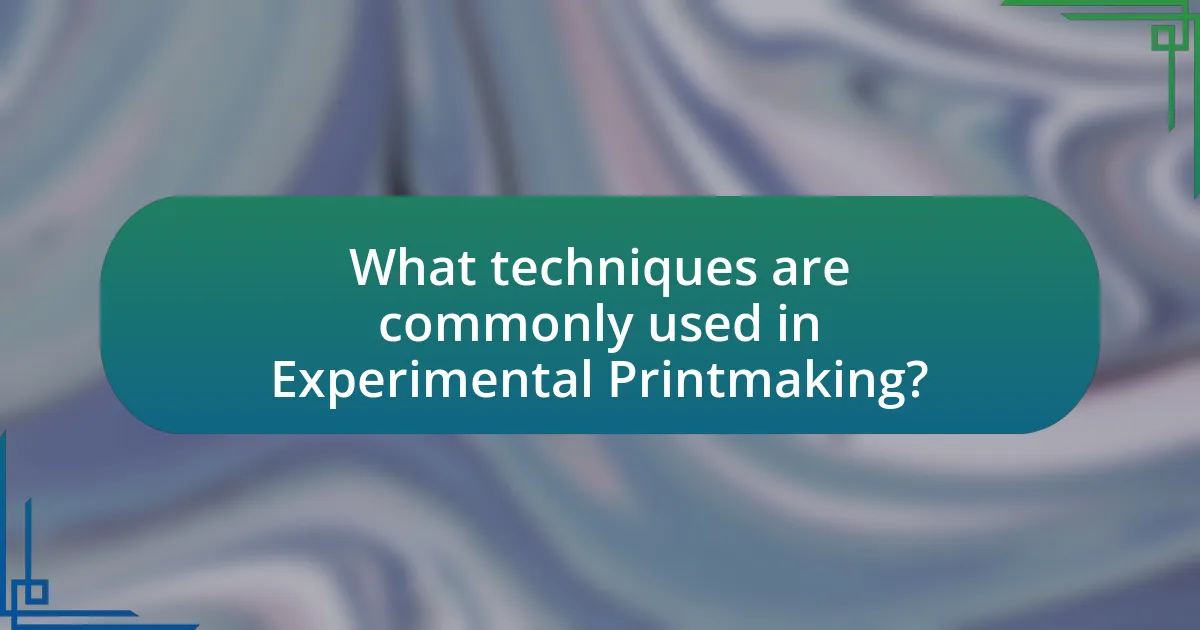
What techniques are commonly used in Experimental Printmaking?
Common techniques used in Experimental Printmaking include monotype, collagraphy, and digital printing. Monotype involves creating a unique print by applying ink to a surface and transferring it onto paper, allowing for spontaneous and one-of-a-kind results. Collagraphy utilizes textured materials glued onto a plate, which can produce rich, layered images when inked and pressed. Digital printing incorporates technology to create prints from digital files, enabling artists to explore new visual possibilities and manipulate images with precision. These techniques exemplify the innovative spirit of experimental printmaking, pushing the boundaries of traditional methods and materials.
How do artists adapt traditional techniques for non-traditional materials?
Artists adapt traditional techniques for non-traditional materials by modifying their methods to accommodate the unique properties of these materials. For instance, when using materials like fabric or metal instead of paper, artists may alter ink formulations or adjust pressure and temperature settings during printing to achieve desired effects. This adaptation is evident in practices such as screen printing on textiles, where artists must consider the flexibility and absorbency of the fabric, leading to innovations in both technique and design. Historical examples include the use of woodblock printing on unconventional surfaces, which has evolved to include materials like glass and plastic, demonstrating the versatility and creativity inherent in experimental printmaking.
What are some innovative techniques that have emerged?
Innovative techniques that have emerged in experimental printmaking include the use of 3D printing, eco-friendly inks, and mixed media approaches. 3D printing allows artists to create intricate textures and forms that traditional printmaking cannot achieve, enhancing the dimensionality of prints. Eco-friendly inks, made from natural pigments and sustainable materials, address environmental concerns while maintaining high-quality results. Mixed media approaches combine various techniques, such as collage and digital manipulation, enabling artists to explore new visual languages and expand the boundaries of printmaking. These advancements reflect a growing trend towards sustainability and creativity in the art form.
How do these techniques affect the final artwork?
Experimental printmaking techniques significantly enhance the final artwork by introducing unique textures, colors, and forms that traditional methods cannot achieve. These techniques, such as using unconventional materials like fabric, found objects, or digital elements, allow artists to explore innovative expressions and push creative boundaries. For instance, the incorporation of non-traditional materials can result in unexpected visual effects and tactile qualities, enriching the viewer’s experience and engagement with the artwork. Additionally, the use of mixed media in experimental printmaking often leads to a more dynamic interplay of visual elements, which can convey complex themes and narratives more effectively than conventional printmaking methods.
What are the benefits of using non-traditional materials in printmaking?
Using non-traditional materials in printmaking enhances creativity and expands artistic expression. These materials, such as found objects, textiles, or unconventional inks, allow artists to explore new textures, colors, and forms that traditional materials may not provide. For instance, incorporating recycled materials can lead to unique prints that reflect sustainability, while using everyday objects can create unexpected patterns and designs. This approach not only fosters innovation but also encourages a dialogue about materiality and the environment in art.
How do these materials enhance artistic expression?
Non-traditional materials enhance artistic expression by providing unique textures, colors, and forms that challenge conventional printmaking techniques. These materials, such as fabric, found objects, and unconventional inks, allow artists to explore new dimensions of creativity, resulting in innovative artworks that reflect personal narratives and contemporary themes. For instance, the use of recycled materials not only promotes sustainability but also encourages artists to engage with social issues, thereby deepening the conceptual layers of their work. This approach has been documented in various art exhibitions, showcasing how artists leverage these materials to push the boundaries of traditional printmaking and expand the dialogue within the art community.
What impact do they have on the viewer’s experience?
Experimental printmaking using non-traditional materials significantly enhances the viewer’s experience by engaging their senses and provoking thought. This innovative approach often results in unique textures, colors, and forms that challenge conventional perceptions of printmaking, inviting viewers to explore the artwork more deeply. For instance, the use of materials like fabric, wood, or found objects can create tactile experiences that encourage physical interaction, making the art more memorable and impactful. Studies have shown that artworks that incorporate diverse materials can elicit stronger emotional responses, as they often resonate with personal memories or cultural contexts, thereby enriching the viewer’s overall engagement with the piece.
What are some notable examples of Experimental Printmaking?
Notable examples of Experimental Printmaking include the works of artists like Robert Rauschenberg, who utilized non-traditional materials such as fabric and found objects in his “Combines,” and Andy Warhol, known for his silkscreen techniques that incorporated commercial imagery. Additionally, artists like Kiki Smith have explored the use of unconventional materials like wax and paper in her prints, pushing the boundaries of traditional printmaking. These examples illustrate how artists have expanded the medium by integrating diverse materials and techniques, thereby redefining printmaking’s possibilities.
Which artists are recognized for their work with non-traditional materials?
Artists recognized for their work with non-traditional materials include El Anatsui, who utilizes discarded bottle caps and aluminum to create large-scale sculptures, and Tara Donovan, known for her installations made from everyday materials like plastic cups and tape. These artists exemplify innovative approaches in contemporary art, pushing the boundaries of traditional mediums. El Anatsui’s work has been exhibited globally, including at the Venice Biennale, highlighting the significance of repurposed materials in art. Tara Donovan’s installations have been featured in major institutions such as the Museum of Modern Art, showcasing the transformative potential of common objects in artistic expression.
What themes are commonly explored in these works?
Common themes explored in experimental printmaking with non-traditional materials include innovation, the intersection of art and technology, and the exploration of identity and culture. These works often challenge conventional techniques and materials, pushing the boundaries of what printmaking can be. For instance, artists may utilize unconventional substrates or incorporate mixed media to create unique textures and visual narratives, reflecting contemporary societal issues or personal experiences. This thematic exploration is evident in the works of artists like El Anatsui, who uses discarded materials to comment on consumerism and cultural identity, demonstrating how experimental approaches can convey profound messages.
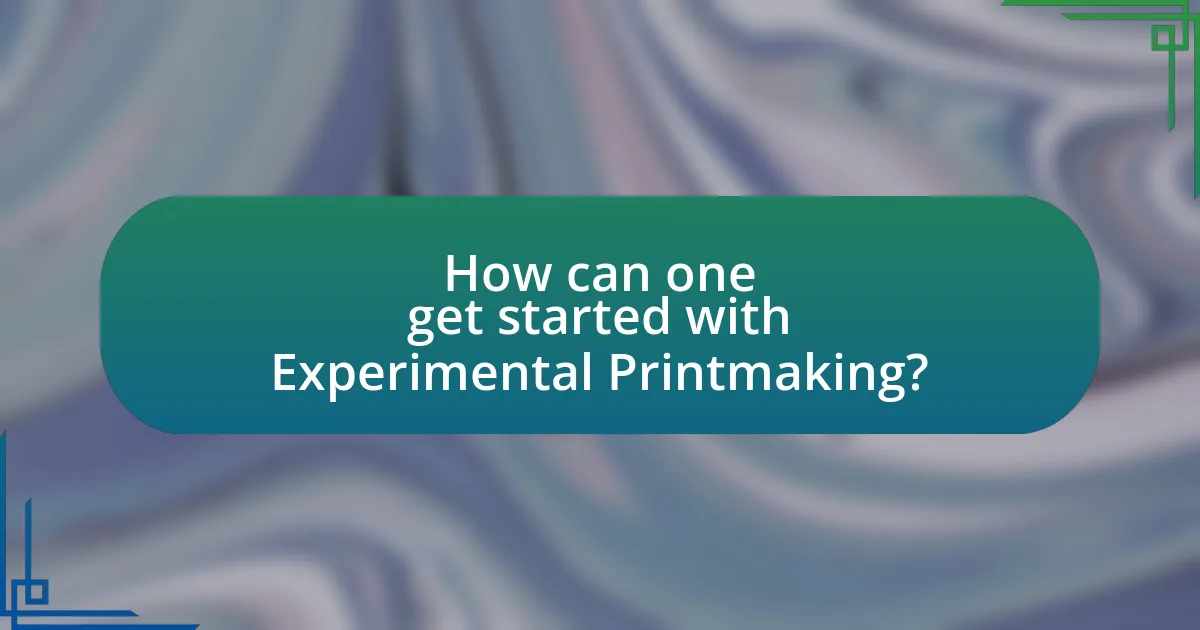
How can one get started with Experimental Printmaking?
To get started with Experimental Printmaking, one should first explore various non-traditional materials and techniques that can be used in the printmaking process. This includes experimenting with items such as fabric, found objects, and unconventional inks, which can lead to unique textures and effects. Engaging in workshops or classes focused on experimental techniques can provide hands-on experience and guidance from experienced artists. Additionally, studying the works of contemporary experimental printmakers can inspire new ideas and approaches. Resources such as books on printmaking techniques and online tutorials can further enhance understanding and skill development in this innovative art form.
What materials and tools are essential for beginners?
Essential materials and tools for beginners in experimental printmaking include a variety of substrates, inks, and printing tools. Beginners should start with paper, cardboard, or fabric as substrates, which are versatile and readily available. Water-based inks are recommended for their ease of use and cleanup. Basic tools such as brayers, rollers, and carving tools are crucial for applying ink and creating designs. Additionally, a printing press or a simple hand-press can enhance the quality of prints. These materials and tools provide a solid foundation for exploring non-traditional printmaking techniques, allowing beginners to experiment and develop their skills effectively.
How can one source non-traditional materials for printmaking?
One can source non-traditional materials for printmaking by exploring local art supply stores, online marketplaces, and recycling centers. Local art supply stores often carry unique items like textured papers, fabrics, and unconventional inks that can be used for printmaking. Online marketplaces such as Etsy or eBay provide access to a wide range of materials, including found objects and specialty supplies from various sellers. Additionally, recycling centers can be a valuable resource for sourcing discarded materials like cardboard, plastic, and other substrates that can be repurposed for printmaking projects. These avenues allow artists to experiment with diverse textures and forms, enhancing their creative expression in printmaking.
What safety considerations should be taken into account?
Safety considerations in experimental printmaking with non-traditional materials include proper ventilation, use of personal protective equipment (PPE), and awareness of material toxicity. Proper ventilation is crucial to minimize inhalation of harmful fumes from solvents and inks, as studies indicate that inadequate airflow can lead to respiratory issues. The use of PPE, such as gloves and masks, protects against skin contact and inhalation of hazardous substances, which is essential given that many non-traditional materials may contain toxic components. Additionally, understanding the toxicity of materials used, such as certain pigments or solvents, is vital; for instance, lead-based pigments are known to pose significant health risks. Therefore, adhering to these safety measures ensures a safer working environment in experimental printmaking.
What tips can help artists succeed in Experimental Printmaking?
To succeed in Experimental Printmaking, artists should embrace innovation by exploring non-traditional materials and techniques. Utilizing unconventional items such as fabric, found objects, or digital tools can lead to unique textures and effects that distinguish their work. Additionally, artists should engage in continuous experimentation, allowing for mistakes to inspire new ideas and methods. Networking with other artists and participating in workshops can provide valuable insights and foster collaboration, enhancing creative growth. Lastly, documenting the process and outcomes of experiments can help artists refine their techniques and develop a personal style, ultimately contributing to their success in the field.
How can experimentation lead to unique artistic outcomes?
Experimentation can lead to unique artistic outcomes by allowing artists to explore unconventional techniques and materials, which often results in unexpected visual effects and forms. For instance, in experimental printmaking, artists may use non-traditional materials such as fabric, found objects, or even digital elements, which can produce distinctive textures and patterns not achievable through standard methods. This approach encourages innovation and personal expression, as artists adapt their processes based on the properties of the materials they choose, leading to one-of-a-kind pieces that reflect their individual creativity and perspective.
What resources are available for learning and inspiration?
Resources available for learning and inspiration in experimental printmaking include online platforms, workshops, and books. Websites like Skillshare and Udemy offer courses specifically focused on non-traditional printmaking techniques, allowing artists to explore innovative methods. Additionally, local art studios often host workshops that provide hands-on experience with unconventional materials. Books such as “Printmaking: A Complete Guide to Materials & Processes” by Bill Fick and Beth Grabowski serve as comprehensive references, detailing various printmaking techniques and inspiring creativity. These resources collectively support artists in expanding their skills and finding new ideas in experimental printmaking.
What common mistakes should be avoided in Experimental Printmaking?
Common mistakes to avoid in experimental printmaking include neglecting proper planning, which can lead to wasted materials and time. Artists often dive into the process without a clear concept or understanding of the materials they are using, resulting in unsatisfactory outcomes. Additionally, failing to test materials and techniques beforehand can cause unexpected reactions or failures in the final print. Not maintaining a clean workspace can also lead to contamination of prints, affecting the quality and integrity of the work. Lastly, overlooking the importance of documentation can hinder the ability to replicate successful techniques or learn from mistakes in future projects.
